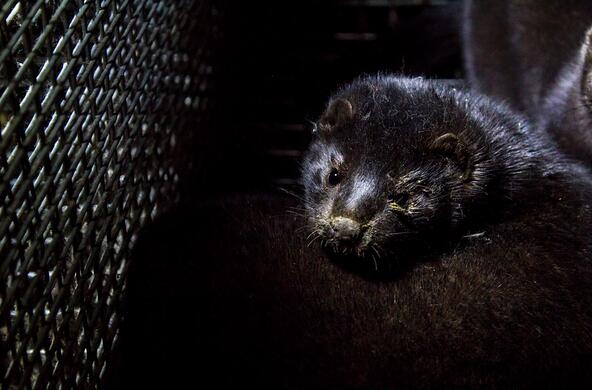
A surprising computer-based study highlights Nebraska and Kansas as possible “hotspots” for mammals carrying viruses with the potential to infect human populations.
Computer models, created by the Cary Institute of Ecosystem Studies in Millbrook, New York, are considered an important new tool in predicting where outbreaks of serious diseases might occur, giving public health experts an opportunity to detect and perhaps avert the threat of deadly epidemics.
The research calls attention to areas with a high probability of viruses spreading from animals to people by identifying rodents capable of carrying the viruses. In the language of researchers these are “zoonotic” diseases – illnesses that cross from animals into people.
Lead researcher Dr. Barbara Han, a disease ecologist with the Cary Institute, led a team that created the computer model. They collected data of the biological traits of hundreds of species of rodents. What they learned about the rodents from all over the world was combined with what was known about existing viruses and parasites. The computer produced a set of maps believed to represent an accurate prediction of which rodents had the “capacity to carry one or more zoonotic diseases” and where these rodents live.
While it’s not known if these rodents currently carry any infectious diseases, Han says the computer model indicates some species on the Great Plains have the capacity to carry one or more zoonotic diseases.
And on Han’s computer-generated maps “those species overlap the most in Nebraska and Kansas.”
All mammals, including rodents, host parasites and viruses. Some become “reservoirs” capable of infecting other animals or humans under the right circumstances. For example, Hantavirus, a sometimes deadly respiratory ailment occurring across large sections of the American west, is spread by dust polluted with the waste of infected mice.
“There are 2,200-plus species of rodents (in the world) and only a fraction of them carry zoonotic diseases,” Han said. “We want to know what distinguishes the reservoirs from the non-reservoirs."
Overtime studies have revealed that different traits in animals make them more hospitable to different strains of viruses. It might be how quickly they reproduce, what they eat, or ability to adapt to different climate conditions.
Humans moving in to or out of the animal’s habitat can also dramatically impact the likelihood of sharing a virus.
The data is amassed to create algorithms which, according to Han “are really useful because they give you a picture of what a disease carrier might look like.”
Han emphasizes “just because an animal has the trait profile suggesting it can carry a zoonotic disease doesn’t necessarily mean it will transmit something to humans” but considers the data of great value in looking for the source of outbreaks and being vigilant areas where disease outbreaks might occur.
The study, published in Spring 2016 by the National Academy of Sciences, stated “forecasting reservoirs of zoonotic disease is a pressing public health priority.”
Familiar outbreaks of zoonotic diseases include Ebola, HIV/AIDS, strains of bird and swine flu, and a variety of forms of plague.
Han says the accumulated data include “some features and traits that are very predictive of whether a species is a reservoir of viruses that can be transmitted to humans.”
Through the process, which scientists dub “machine learning,” the computer learns to identify and recognize traits and patterns.
“The computer learns this pretty well,” Han said. The models have an 85 to 90 percent accuracy rate in distinguishing whether an animal is carrying zoonotic diseases, according to the study.
There is no known immediate risk to anyone in Nebraska or Kansas. Han is quick to make clear the speculative models show where disease and rodents could be a factor, not where there is an imminent risk or known virus.
Dr. Ali S. Khan, dean of the College of Public Health at the University of Nebraska Medical Center, read the study and agrees.
“Until we figure out whether this rodent is infected with anything it’s too early to say there is any risk to anybody here in Nebraska.”
Nonetheless, Khan says it’s not a study to be dismissed and he welcomes having an additional tool that might predict where diseases might be a risk.
“Zoonotic diseases tend to be so troublesome because we often have no treatment and no vaccine for them,” Khan said. “They're frequently very scary diseases that don't just stop but continue to go on and infect additional humans.”
Khan called the study a “really elegant” use of machine learning.
The maps (see inset) are color coded, with the bright red and orange “hotspots lighting up the map” in Han’s words, making the hundreds of miles of land in Nebraska and Kansas especially notable.
Dr. Scott Gardner, a biologist at the University of Nebraska-Lincoln and curator of parasitology at the University of Nebraska State Museum, knows both animals to be “good hosts for zoonotic diseases.” He is especially familiar with the grasshopper mouse, having traveled as far as Mongolia and Bolivia to trap the mice and study their parasites.
On a recent trapping trip Gardner and two doctoral students laid out traps on a ranch northwest of Ogallala, Nebraska. They caught one of the big-eyed brown mice in a live trap.
“Beautiful animal,” Gardner declared.
It’s cute but deadly. “The Killer Mouse” earned its nickname because they are carnivores who will kill other rodents, Gardner said.
“When they make a kill, they stand up on their back feet and go, ‘pss, pss, pss,’” Gardner demonstrated. “They yell when they kill something.”
His study of the parasites and viruses and the potential for “spillover” to humans long ago convinced him of the need for more field work identifying the links between mammals and new diseases in humans. He and a group of other researchers co-authored a study in 2014 noting big gaps in the data necessary to understand where zoonotic disease outbreaks may occur. They recommended a strategy to collect and store biologic samples for future reference.
Gardner says it’s important to store and make available to researchers items such as “heart, liver, kidney, lungs” and “have them available and then keep doing it year after year and find out what's there.”
That would allow researchers to “explore those for various viruses, do complete genome sequences, then if we see something emerging or changing then we know that something is going on.”
Gardner feels the Cary Institute’s computer models may be lacking a complete picture to make accurate predictions.
“We’re not able to make predictions because we don't have enough data to make predictions,” Gardner said. “We can do these models all we want but we have to have some ground proof data first before we can make predictions with the model.”
The models, Han points out, are designed to be a work in progress.
“The more data you give it the better it’s trained, the better it learns and the more accurate results it will produce,” she said. “Just being aware of what animals are out there and what they are known to carry as far as diseases is a good starting point and these maps can help inform that.”
State of Nebraska public health officials agree computer modeling can be a useful tool along with in-the-field reporting of suspicious cases.
State epidemiologist Dr. Tom Safranek says the study underscores how health care providers in the region need to be on the lookout for “unusual, undiagnosed” symptoms causing serious health problems. Safranek urged doctors and nurses to make use of the state’s system to report unique cases, to allow investigators to “pursue identification of the causes of a health problem.”
RESEARCH
Journal articles by Dr. Han and her research team:
The Proceedings of the National Academy of Sciences
Trends in Parasitology








